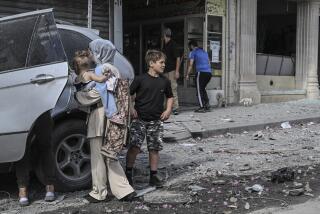Arafat Speaks Out of Both Sides of His Mouth
- Share via
The most important breakthrough achieved by the 1993 Oslo accords between Israel and the Palestinians--or so it seemed--was the change in the formal Palestinian definition of the term “Israeli-occupied territories.”
Before Oslo, that definition encompassed the entire Jewish state, including Tel Aviv, Haifa and West Jerusalem. After Oslo, Yasser Arafat and the Palestinian Authority, in diplomatic statements, restricted that term to the territories occupied by Israel in the 1967 Six-Day War--the West Bank and Gaza.
The trouble was that, in addressing Arab audiences post-Oslo, they continued to hint, and sometimes say outright, that the real definition of “Israeli-occupied territories” was still the original one--”from the sea to the river,” as the late, celebrated moderate Palestinian Faisal Husseini put it in June.
Moreover, in Palestinian schools, official textbooks continued to deny the legitimacy of Israel, which was recognized by the Palestine Liberation Organization in 1993. Maps of the Middle East were provided, but Israel didn’t exist on them--the state of Palestine appeared in its place. Palestinian Authority publications anticipated Israel’s “elimination” and referred to it as “the Zionist entity.”
The Jewish state continued to be presented as an imposed foreign body that will, in time, disappear.
It was as if, while speaking in English about peace, Arafat and his Palestinian Authority had wanted to convey in Arabic a very different message: Have patience. The strategy for achieving in one blow our goal of a state in all of Palestine and getting rid of the Zionist occupiers hasn’t worked. Now we have a smarter way. Once we get the West Bank and Gaza as a state, we’ll be in a much stronger position to get the rest.
The vast majority of Israelis, desperate for an end to violence, chose to hear the definition of “Israeli-occupied territories” as it was articulated by Palestinian officials for Western consumption--the West Bank and Gaza. They wanted to embrace this definition because it was compatible with their hopes for acceptance and peace.
They chose to ignore the definition used by Hamas and Islamic Jihad--whose definition of “Israeli-occupied territories” has always included all of Israel, whether articulated in English or in Arabic--because they considered those groups to be only marginal.
Events during the past 18 months have changed all that.
In July 2000, at Camp David II, then-Israeli Prime Minister Ehud Barak made a daringly generous territorial offer in exchange for an end to the conflict.
To the astonishment of Israelis, Arafat refused to even make a counter offer.
Then came the latest intifada, the armed attacks on Israelis by Arafat’s own forces, the suicide bombings of Israeli civilians by Hamas and Islamic Jihad, the Palestinian polls showing overwhelming support for the bombers, the unwillingness by Arafat to rein in the terrorists and the increasing evidence that support by Palestinians for Hamas and Islamic Jihad is greater than their support for Arafat’s Palestinian Authority.
In the wake of the past week’s murderous storm of Palestinian suicide bombings, even the Israelis who desperately wanted to believe Arafat’s words in English no longer do so.
The peace process, given such a hopeful life eight years ago by that handshake on the White House lawn, has now collapsed. Its resurrection will require nothing less than the emergence of a new Palestinian leadership that unambiguously--in both English and Arabic--accepts Israel’s legitimacy, that is able and willing to stop the violence of those who refuse to do so and that can hold the support of the Palestinian community.
Only then will we be able to go back to Oslo.
And only then will we be able to get on with peace.
*
Walter Reich, a psychiatrist, is professor of international affairs, ethics and human behavior at George Washington University and a senior scholar at the Woodrow Wilson Center. He was director of the U.S. Holocaust Memorial Museum from 1995 to 1998.
More to Read
Sign up for Essential California
The most important California stories and recommendations in your inbox every morning.
You may occasionally receive promotional content from the Los Angeles Times.













